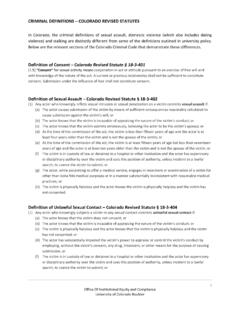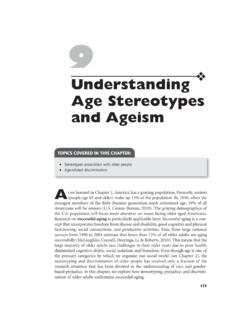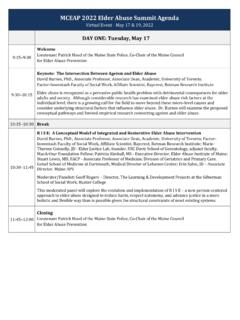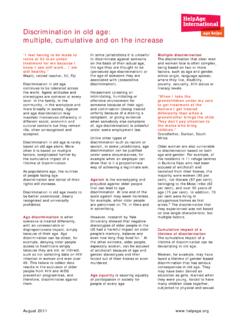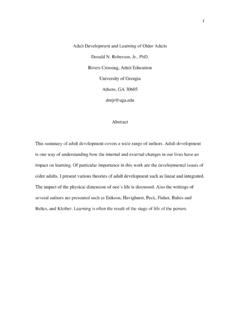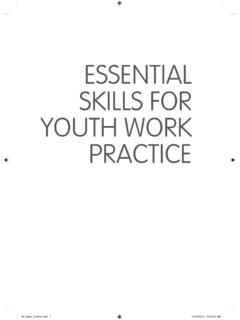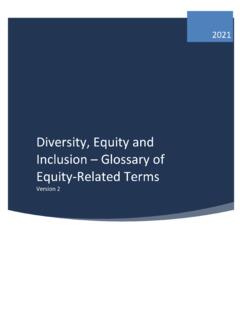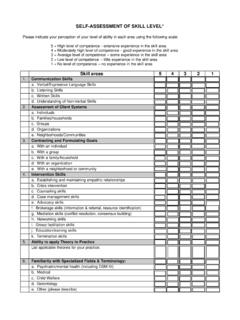Transcription of Age, Race, Class and Sex: Women Redefining Difference
1 Age, Race, Class and Sex: Women Redefining DifferenceAudre LordePaper delivered at the Copeland Colloquium, Amerst College, April 1980 Reproduced in: Sister Outsider Crossing Press, California 1984 Much of Western European history conditions us to see human differences in simplistic opposition to each other: dominant/subordinate, good/bad, up/down, superior/inferior. In a society where the good is defined in terms of profit rather than in terms of human need, there must always be some group of people who, through systematized oppression, can be made to feel surplus, to occupy the place of the dehumanized inferior. Within this society, that group is made up of Black and Third World people, working- Class people, older people, and a forty-nine-year-old Black lesbian feminist socialist mother of two, including one boy, and a member of an interracial couple, I usually find myself a part of some group defined as other, deviant, inferior, or just plain wrong.
2 Traditionally, in american society, it is the members of oppressed, objectified groups who are expected to stretch out and bridge the gap between the actualities of our lives and the consciousness of our oppressor. For in order to survive, those of us for whom oppres sion is as American as apple pie have always had to be watchers, to become familiar with the language and manners of the oppressor, even sometimes adopting them for some illusion of protection. Whenever the need for some pretense of communication arises, those who profit from our oppression call upon us to share our knowledge with them. In other words, it is the responsibility of the oppressed to teach the oppressors their mistakes. I am responsible for educating teachers who dismiss my children's culture in school. Black and Third World people are expected to educate white people as to our humanity. Women are expected to educate men. Lesbians and gay men are expected to educate the heterosexual world.
3 The oppressors maintain their position and evade responsibility for their own actions. There is a constant drain of energy which might be better used in Redefining ourselves and devising realistic scenarios for altering the present and constructing the rejection of Difference is an absolute necessity in a profit economy which needs outsiders as surplus people. As members of such an economy, we have all been programmed to respond to the human differences between us with fear and loathing and to handle that Difference in one of three ways: ignore it, and if that is not possible, copy it if we think it is dominant, or destroy it if we think it is subordinate. But we have no patterns for relating across our human differences as equals. As a result, those differences have been misnamed and misused in the service of separation and there are very real differences between us of race, age, and sex. But it is not those differences between us that are separating us.
4 It is rather our refusal to recognize those differences, and to examine the distortions which result from our misnaming them and their effects upon human behavior and , the belief in the inherent superiority of one race over all others and thereby the right to dominance. Sexism, the belief in the inherent superiority of one sex over the other and thereby the right to dominance. Ageism. Heterosexism. Elitism. is a lifetime pursuit for each one of us to extract these distortions from our living at the same time as we recognize, reclaim, and define those differences upon which they are imposed. For we have all been raised in a society where those distortions were endemic within our living. Too often, we pour the energy needed for recognizing and exploring Difference into pretending those differences are insurmountable barriers, or that they do not exist at all. This results in a voluntary isolation, or false and treacherous connections.
5 Either way, we do not develop tools for using human Difference as a springboard for creative change within our lives. We speak not of human Difference , but of human , on the edge of consciousness, there is what I call a mythical norm, which each one of us within our hearts knows "that is not me." In America, this norm is usually defined as white, thin, male, young, heterosexual, Christian, and financially secure. It is with this mythical norm that the trappings of power reside within this society. Those of us who stand outside that power often identify one way in which we are different, and we assume that to be the primary cause of all oppression, forgetting other distortions around Difference , some of which we ourselves may be practising. By and large within the Women 's movement today, white Women focus upon their oppression as Women and ignore differences of race, sexual preference, Class , and age. There is a pretense to a homogeneity of experience covered by the word sisterhood that does not in fact Class differences rob Women of each others' energy and creative insight.
6 Recently a Women 's magazine collective made the decision for one issue to print only prose, saying poetry was a less "rigorous" or "serious" art form. Yet even the form our creativity takes is often a Class issue. Of all the art forms, poetry is the most economical. It is the one which is the most secret, which requires the least physical labor, the least material, and the one which can be done between shifts, in the hospital pantry, on the subway, and on scraps of surplus paper. Over the last few years, writing a novel on tight finances, I came to appreciate the enormous differences in the material demands between poetry and prose. As we reclaim our literature, poetry has been the major voice of poor, working Class , and Colored Women . A room of one's own may be a necessity for writing prose, but so are reams of paper, a typewriter, and plenty of time. The actual requirements to produce the visual arts also help determine, along Class lines, whose art is whose.
7 In this day of inflated prices for material, who are our sculptors, our painters, our photographers? When we speak of a broadly based Women 's culture, we need to be aware of the effect of Class and economic differences on the supplies available for producing we move toward creating a society within which we can each flourish, ageism is another distortion of relationship which interferes without vision. By ignoring the past, we are encouraged to repeat its mistakes. The "generation gap" is an important social tool for any repressive society. If the younger members of a community view the older members as contemptible or suspect or excess, they will never be able to join hands and examine the living memories of the community, nor ask the all important question, "Why?" This gives rise to a historical amnesia that keeps us working to invent the wheel every time we have to go to the store for find ourselves having to repeat and relearn the same old lessons over and over that our mothers did because we do not pass on what we have learned, or because we are unable to listen.
8 For instance, how many times has this all been said before? For another, who would have believed that once again our daughters are allowing their bodies to be hampered and purgatoried by girdles and high heels and hobble skirts?Ignoring the differences of race between Women and the implications of those differences presents the most serious threat to the mobilization of Women 's joint white Women ignore their built-in privilege of whiteness and define woman in terms of their own experience alone, then Women of Color become "other," the outsider whose experience and tradition is too "alien" to comprehend. An example of this is the signal absence of the experience of Women of Color as a resource for Women 's studies courses. The literature of Women of Color is seldom included in Women 's literature courses and almost never in other literature courses, nor in Women 's studies as a whole. All too often, the excuse given is that the literatures of Women of Color can only be taught by Colored Women , or that they are too difficult to understand, or that classes cannot get into them because they come out of experiences that are too different.
9 I have heard this argument presented by white Women of otherwise quite clear intelligence, Women who seem to have no trouble at all teaching and reviewing work that comes out of the vastly different experiences of Shakespeare, Moliere, Dostoyefsky, and Aristophanes. Surely there must be some other is a very complex question, but I believe one of the reasons white Women have such difficulty reading Black Women 's work is because of their reluctance to see Black Women as Women and different from themselves. To examine Black Women 's literature effectively requires that we be seen as whole people in our actual complexities as individuals, as Women , as human rather than as one of those problematic but familiar stereotypes provided in this society in place of genunine images of Black Women . And I believe this holds true for the literatures of other Women of Color who are not literatures of all Women of Color recreate the textures of our lives, and many white Women are heavily invested in ignoring the real differences.
10 For as long as any Difference between us means one of us must be inferior, then the recognition of any Difference must be fraught with guilt. To allow Women of Color to step out of stereotypes is too guilt provoking, for it threatens the complacency of those Women who view oppression only in terms of to recognize Difference makes it impossible to see the different problems and pitfalls facing us as , in a patriarchal power system where whiteskin privilege is a major prop, the entrapments used to neutralize Black Women and white Women are not the same. For example, it is easy for Black Women to be used by the power structure against Black men, not because they are men, but because they are Black. Therefore, for Black Women , it is necessary at all times to separate the needs of the oppressor from our own legitimate conflicts within our communities. This same problem does not exist for white Women . Black Women and men have shared racist oppression and still share it, although in different ways.








